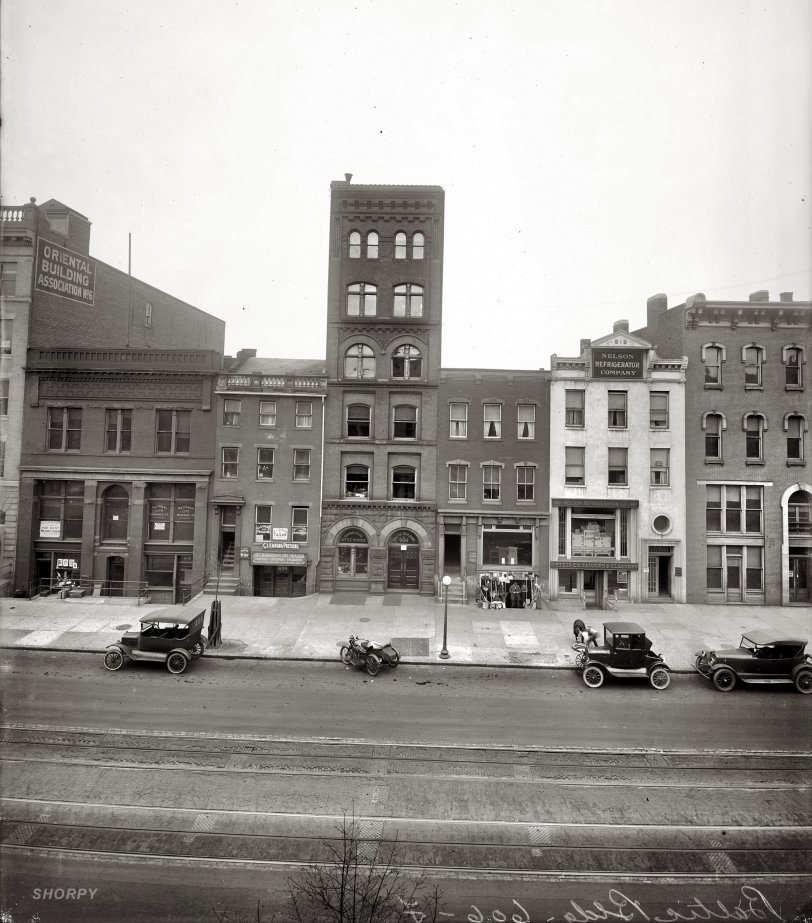


Framed or unframed, desk size to sofa size, printed by us in Arizona and Alabama since 2007. Explore now.
Shorpy is funded by you. Patreon contributors get an ad-free experience.
Learn more.

- Lofty addition
- In 1912
- Keenan Building
- Six years old
- Taken from the P.J. McArdle Roadway?
- It stood only 47 years
- Three track mind
- Incline to the right
- Reach for the sky, 1912 style
- No clean sweep
- Same Job Title, Same Face
- Sadly Lost
- Beautiful ...
- Where you get your kicks
- Aim High
- Pueblo Revival sisters
- Pueblo Neoclassicism
- Milk Man
- Regional dialect.
- Spielberg's inspiration
- Great Photo
- Loaf Story
- Do you still have the Rakes category?
- Could almost be a scene from the 1957 movie 'Hell Drivers'
- The Wages of Fear.
- Conspicuous by their absence
- Got Milk?
- All that aluminum
- No lefties
- Smoke 'em if you've got 'em
Print Emporium
Street View: 1921

Washington, D.C., circa 1921. "Baltic Building, 606 F Street." View full size. National Photo Company Collection glass negative, Library of Congress.
Street-level (or not) entrances
While I can't prove it, I would bet good money the varying levels of the street entrances are due to grading of the road, which would have occurred in the 1870s under Boss Shepherd's extensive program of paving and grading. The buldings constructed after the grading would have floors level with the current street. Older ones that end up with their former entrances below street level might reconfigure to make the second floor the new first floor, as appears to be what happened with #604 and #608.
My First Tux
Probably showing my age here, but I purchased my first tuxedo from Stein's.
Third Rail Politics
Re-reading the comments Dave links to below regarding the underground third rail leaves the impression that overhead wires were not used in D.C. because they were ugly and often knocked over by trucks. It is true that some people consider overhead wires ugly, but the streetcar companies were not making such aesthetic choices out of the kindness of their hearts. Congress actually enacted a law banning the use of overhead wires within the bounds of the original city plan of L'Enfant. This law is still in effect and is leading to complications as the city seeks to re-introduce streetcars in areas not served by Metro: specifically along H Street NE. Some recent articles about the issue (Boston Examiner, Rebuilding Place in the Urban Space, The Overhead Wire)
Streetcar tracks
I know that groove in the center of the car tracks is supposed to be for a third rail shoe, but do you suppose it might actually be a slot for a cable car route? Cable cars were in many cities besides San Francisco. I notice that there are iron covers all along the "third rail" and wonder why. One seems to say "Meter" or something like that, but it stands alone while the others are all up against the "third rail" slot. When did DC get electric street cars anyway? Anyone know?
[No cable cars. We have many comments [1, 2] detailing the technical particulars of the Washington, D.C., streetcar system. - Dave]
Varied Facades
Hi All, I'm traveling this week so my typical connection to the historical archives at the Washington Post is not working - I feel somewhat lost without it: no keyword searches for all the wonderful store names in this photo.
What strikes me most visually about this photo is the diversity of the front doors to these businesses: each has its own style but additionally, they are functionally so different. Some are street level (#606, #612) while others are raised (#604, #608). The oddest is #602 with a sunken entrance: I wonder if there was once a flight of cast-iron stairs up to the central arched window that have since been removed? Also peculiar is #610: a street level door with interior stairs leading to the raised refrigerator showroom: plus that wonderful circular window over the door. The cornice of #610 is rather traditional but it seems like they have tried for a more modern streetscape, perhaps to match the thoroughly modern, high-tech refrigeration marvels inside.

Which is which?
I love the "Joe Baruch and Joe Braugh" sign. "Baruch & Braugh" sounds better, but apparently they want to be known as a couple of regular Joes.
Fix a Flat
Looks like the people next to the small Flivver to the right are busy fixing a flat. Very interesting to see how small the Ford looks compared to the big car parked behind it! Also it's nice to see how these photos are not posed, but scenes of real life back then. Amazing!
Last one standing
The OBA Bank building visible at far left is still standing, but the rest of this block has been razed:

Signs of Life
The signs of life in the upper windows of these buildings are intriguing. The doll in the second building from the left, the iron bedstead curve in the second from the right.
On the street -- the broom seller and the men changing the tire. If I were a high-school American history/literature teacher, I would make Shorpy daily required viewing.
Nice Harley
That's a nice Harley Davidson. I wonder how the guys will air up the tire they are changing on the model T? Can you say bicycle pump?
























On Shorpy:
Today’s Top 5